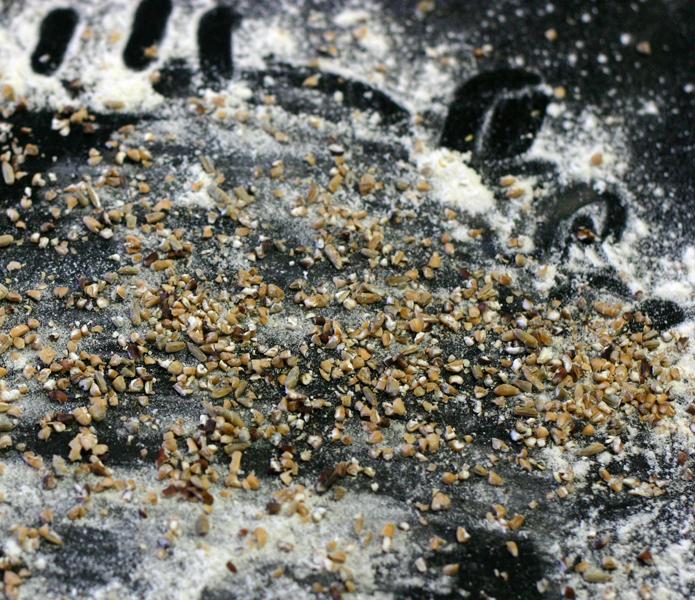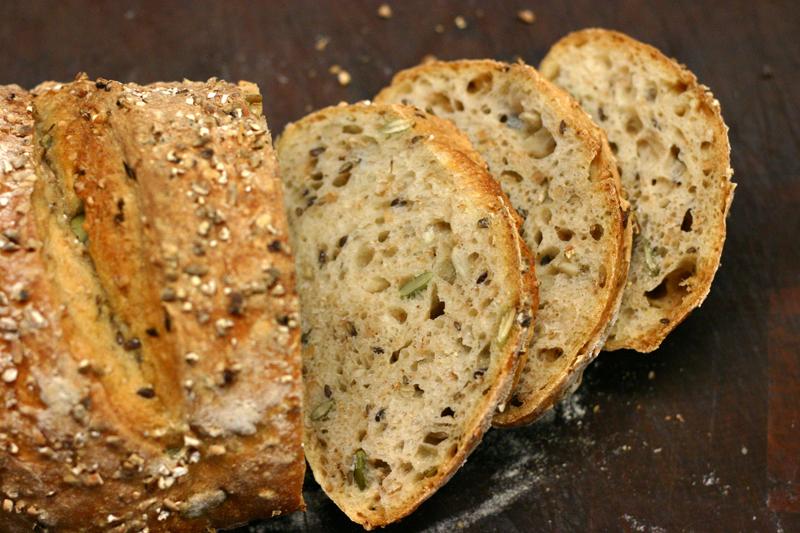-
Posts
1,664 -
Joined
-
Last visited
Content Type
Profiles
Forums
Store
Help Articles
Everything posted by lesliec
-
I haven't thought about it, but yep, I guess we do. I have seen yellow ones, but not often and not recently. I like the things, particularly in the cocktail above, but they're getting freakin' expensive - NZ$15/kg last time I looked.
-
Yep, nothing like a sour one for ... sourness. If you're eating them straight from the skin (and be assured; that's a good thing to do with them), a nice sprinkle of sugar makes a lot of difference. But try them in a cocktail. This is one of Wifey's specialties so I'm a little vague, but essentially - use a stick blender to blast three or four tamarillos (preferably ripe, skin removed. Leave the seeds in). Add vodka, Cointreau and sugar syrup to taste. Strain over shaved ice (the straining bit is entirely optional). Enjoy, but don't spill it on your best white shirt - the colour is amazing.
-
I'm jealous - wish we could get it like that here!
-
I discovered one in one of our books this week called a Campari Crush. 30ml each gin and Campari poured over lots of ice in a highball glass, segment of lime squeezed and dropped in then topped up with grapefruit juice. We used a shorter glass, so the proportion of grapefruit was lower. The Campari was clearly there, as is its wont, and we felt we wouldn't want to change the mix to add more grapefruit. Definitely one to do again (and I did, last night!).
-
Nick, those cucumbers look amazing! Is your sealer this one? I'll be interested to hear your comments on how it performs - I haven't taken the plunge yet, but I wanna.
-
Hi Toufas. Try cookingissues. They have a good breakdown of the different types, including GS. They don't mention EB - did you mean GB? Happy glueing ...
-
Chris, in your part of the world look out for Murray River salt - delicate pink flakes. It's now our standard 'best' salt at home. I've done a highly unscientific, non-blind comparison with the standard iodised supermarket stuff. It's hard to describe the taste of salt other than 'salty', but the supermarket stuff seems to have a harshness the Murray River doesn't. I still use the ordinary for 'bulk' applications like pasta, etc., but the Murray is prettier on the table and in the small bowl beside my cooktop.
-
My local supermarket had a special on what they called veal cutlets on Saturday - I suspect a cancelled export order, to judge from the packaging. They consist of racks of eight tiny rib bones. Since they're about the same size and shape of lamb racks, for which I find SV particularly good, I thought I'd try the same time/temp and see how it goes (for lamb I go with 56°C for two or three hours, followed by a sear). Any alternative suggestions?
-
I remember - not fondly - tinned (canned) peas. Unfortunate off-green colour, squishy texture, taste like .. well, I could say but it would be an insult to makers of good Pinot Noir. I could never understand why anybody would buy them rather than frozen or even dried. 'Gravy' ingredients like Bisto result in something which looks a bit like gravy but doesn't taste remotely like juice-from-meat. Much better to use ... well, juice from meat. And yes, water. The stuff from the tap is just fine for me.
-
Phones are coming out with ever-better cameras. My Xperia Arc has one of the fastest lenses (f2.4) I've heard of on a phone - one of the main reasons I chose it - and makes a great job of restaurant photos. As daydayxvi said, we're now able to avoid shutter noises, and with faster lenses flash is just not necessary (quite apart from it making the plates look awful. Brightly-lit, but awful). If you're discreet and don't bother other diners, I can see little objection to doing anything you like with your food once it's on the table.
-
I can certify that cider works just fine in the M&C with gruyere and cheddar. White wine should be fine; I don't think the higher alcohol should cause any problems, as whatever percentage you start with will be reduced somewhat by the heat. But of course if the stuff doesn't behave, blame the alcohol!
-
Hi Chris. Welcome to the world of chocolately alcohol! (We were introduced to chocolate vodka recently, but that's another story.) A few years back, when my son decided he wanted to do a bartender's course and prevailed upon Mummy and Daddy to get a few supplies in so he could practice (damn the child; he started a very expensive habit in us!), we invented a pair of cocktails we decided to call Cheech and Chong. There was some logic to this; the Cheech consisted of peach schnapps and creme de cacao (CHocolate/pEACH, geddit?) and ... something else (vodka, I think; it was OK, but not our best), but the Chong (CHocolate/OraNGe) is worth sharing. We used white creme de cacao, but I see no reason your brown stuff wouldn't taste as nice. Half fill a shot glass with C de C. Layer on top a similar quantity of Grand Marnier. Take as much as you can manage into your mouth in one go and hold it there as long as you can stand it, then swallow. I dare you not to smile!
-
Hi Kit. Can you spell J-E-A-L-O-U-S? I haven't been to Beaune for a few years, but something you must do is a nice long walk out to the south along the Route de Pommard (once you're past the roundabout it becomes the Route de Beaune). I can't see it on Google Earth, but you should pick up a walking track (or maybe it was just minor roads) which takes you through the vineyards to Pommard and Volnay, and as far beyond as you can manage (there may be buses you can catch back to Beaune; not sure - I just walked!). Wonderful countryside to enjoy, even if you don't go into any of the wineries. A similar walk I did was from Gevrey-Chambertin (bus from Dijon) along the Route des Grands Crus as far as Vosne-Romanée for lunch, then back again. Highly recommended. I'd love to give you a restaurant recommendation, but I can't remember the name of the one I enjoyed so much I went back two nights running. No doubt it would have changed since 2004, anyway. You'll find some good things. Enjoy yourselves!
-

Le Cordon Bleu comes to town
lesliec replied to a topic in Australia & New Zealand: Cooking & Baking
It's been far too long since I posted a progress update on the building of the Wellington Le Cordon Bleu school. Allow me to make up for it ... The local website has been up and running for a while. Be sure to check the Blog section; Le Cordon Bleu's ambassadors and staff are, among other things, busily exploring Shanghai (ambassador/chef Robert Oliver is based there) and cooking their way through a set of Cordon Bleu Cookery Course magazines from 1968! The official opening of the school is scheduled for early October, with the first courses starting a little before that. In the building itself, the earthquake strengthening is complete, much of the outside is finished and there's a lot of work going on inside to fit out the school for its first group of students in just a few months. Compare the first photo in post #1 above with this: The angles are a little different, but this is the current view of the Cuba Street frontage, where the main entrance will be. Inside, the school extends over four levels (apparently, from a seismic point of view it's actually three buildings). The first level will have barista and bar training (handled by partner WelTec), along with several small classrooms. There's also a student commons/library/hangout area looking out onto Manners Street; right now, it looks like this: Further up the building there'll be specialist Cuisine and Patisserie kitchens, lecture theatres and a full (100-seat) restaurant with a large tutorial kitchen. There's still plenty of work to be done putting it all together, but the extractor vents are going up: This is one of the big kitchens. Soon there'll be a row of ovens and cooktops running the length of the room under the extractors. What I like about the layout is that there'll be big windows over to the right of the photo (behind the people) looking in from a walkway, so visitors will be able to see what's happening without getting in the way. The restaurant looks like this: The restaurant will of course be open to the public and run by the students; WelTec hospitality students will handle front-of-house and the bar, with Le Cordon Bleu students doing the cooking out the back. Things will move quickly now the interior work is on the go. I'll try to arrange another visit in a month or two to report on further progress. -
Running a blowtorch over the cut surfaces would help kill the nasties. Or, as Chris mentioned, boiling water. Chris couldn't remember the timing and neither can I, but my memory from discussions in the SV thread is that you just need to dunk the meat in and out (watch your fingers!).
-

"Artisan Bread in Five Minutes a Day" Zoe Francois (2010–)
lesliec replied to a topic in Pastry & Baking
Hi, Rotuts. Welcome back to breadmaking! I also have a lame like yours but I've found it completely useless for this recipe. I suspect it's because of the high moisture content in the five-minute dough; something more serious is required. There's a photo of the bread knife I use for slashing over here in my earlier post about shaping - it doesn't get stuck and drag its way through like the lame does, but Jmahl's scissor idea is good too. Is your cat a British Blue? Two of them own me! -

"Artisan Bread in Five Minutes a Day" Zoe Francois (2010–)
lesliec replied to a topic in Pastry & Baking
The planets were in alignment last night, so here are the photos threatened/promised above ... A blob of dough, straight from my container. Note interesting seeds: A sprinkle of kibbled grains on the benchtop, ready for the part-folded loaf to be plopped onto to finish shaping (this is after the 'fold the edges into the middle, then flatten a bit' stage and before the 'fold one edge over' stage): Shaped, slashed and ready for the oven: Half an hour or so later: And this morning, ready for my toast: I really like this mix with the kibbled grain, sunflower, pumpkin and flax seeds. One caution; not wishing to be indelicate, but if you eat enough the effect on one's bowels is, let's say, not insignificant! -
Robert, I'm getting jealous of your toys! My usual technique when making the triple-cooked chips is to do cook #1 as early as I can on the day I'm planning to serve them, keeping them (after they've cooled down) in the fridge all day on a rack. Such was my plan a couple of days ago, but circumstances, in the form of something more perishable, intervened and delayed the the steak I had planned until yesterday. The chips therefore spent an extra 24-odd hours in the fridge and were eventually among the very best I've done. Not saying I wouldn't use other techniques (vacuum, dehydrators, etc.) if I had them, but a long rest in the fridge between the first and second cooking gives a great result. Good luck with the ultrasonics - we expect reports.
-
... and Valereee (welcome to eG and SV, by the way), note the significance of the 'closed cell' bit in the name of the foam. Closed cell is essentially a bunch of individual little bubbles; it 'heals' from having a probe poked through it far better than non-closed cell and thus maintains the seal of your bag.
-

"Artisan Bread in Five Minutes a Day" Zoe Francois (2010–)
lesliec replied to a topic in Pastry & Baking
That is a beautiful loaf. I've also been fiddling with the basic recipe and have a variant which is gaining rave reviews (at home). I substitute just under a cup of whole wheat flour for one of the six cups of white in the standard recipe, plus I throw in about ½ - ¾ cup of kibbled grains and a rough handful each of pumpkin seeds, sunflower seeds and linseed (aka flax seeds). When forming the loaf (this method) I roll the dough in a bit more kibbled grain. The texture is if anything slightly lighter than the 'plain white' version, with a good crunch to the crust being helped by the kibbled grain sticking to it. I'll see about a photo sometime soon. -
I know of no reason at all not to use the stems, which seem to have plenty of juice and flavour in them. I make a kind of rustic pesto (basil, garlic, oil, S&P) which I use to coat chicken before roasting quite hot, and I always use all the basil in my mortar and pestle. And for the last little while I've been dropping some fresh basil - stem and all - into my juicer along with orange and apple in the morning (we keep a growing plant on the bench where the juicer lives). Rather nice and different. Coriander is good for this too.
-

My crock pot is full of lead. Can you recommend one that isn't?
lesliec replied to a topic in Kitchen Consumer
I think the general advice about using a crockpot for SV would be 'don't'. Because of the thick walls and (if I remember correctly) the heating elements being in the walls, your PID will have trouble keeping the temperature stable. You're better with a basic rice cooker - thin walls, no frills - where the PID won't have to work so hard to control overshoots. -
Hi Justin. I like the sound of that. A possibility you may not have considered is to bag and cook the steak until nearly done then chill it, remove the bag and insert the scallop. You could cut the hole either at this stage or right at the beginning - I'm thinking I'd do it after the initial cook but I can't think of a really compelling reason either way! I don't have personal experience with Activa; would it still bond to a partly-cooked steak? Anyway, after the scallop's in its meaty nest, re-seal the steak and finish cooking (not necessarily immediately - I'd think you could hold it in the fridge for a while if you wanted to). I don't think the meat would provide much/any insulation for the scallop since presumably at least one side is in contact with the bag, so cooking the whole thing for 80 minutes doesn't sound like a good idea. And to cut the hole something like these guys should work. Let us know how it turns out. We expect photos ...
-
I tried the Gordon technique Christmas before last. The turkey was cold!
-
I've been using something like this methoud since I got my lovely induction hob just on a year ago. Step 1: start heating water on maximum (simply because it's going to boil sooner that way) Step 2: break my egg into a small glass dish (a saucer should work just fine) Step 3: when the water is boiling vigorously, set up a nice whirlpool by stirring with a slotted (or any) spoon. Slip the egg into the middle of the vortex - the idea is to use the swil to keep everything together - and immediately drop the heat to level 3 (you'll need to experiment to find the right level for your equipment, but 3 for me keeps things at no more than a slight simmer). Simultaneously (using your third hand if necessary!) start a timer for three minutes Step 4: about a minute into the three minutes start the toaster. Again, the timing of this will vary depending on your equipment Step 5: as soon as the timer beeps, turn off the heat, carefully scoop out the egg and place it lovingly on a piece of toast. Embrace with salt to taste. Works every time - nice runny yolk, not much mess with the white, no acid needed in the water. I haven't tried more than one egg at a time, but my feeling is that two wouldn't need more than another 30 seconds added to the three minutes - dependent partly on how much water you're using (more = less drop in temp when the eggs go in).










